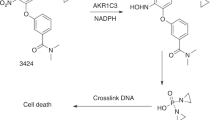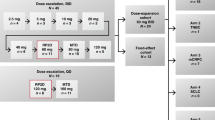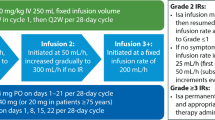Abstract
The dose limiting toxicities of the short infusion trial of the dacarbazine analog, CB10-277, were nausea and vomiting which appeared to be related to the peak plasma level of the parent drug. In addition, based on mouse studies, these dose limiting toxicities occurred at a less than optimal level of the monomethyl metabolite, the presumed species required for antitumour activity. An alternative schedule that would avoid the parent drug peak plasma levels of short infusion, while possibly allowing an increase in the amount of monomethyl metabolite produced was considered. Thus, a 24 h continuous infusion schedule, repeated every 21 days was explored. Twenty-two patients received 42 courses with a dose range of 4,700-15,000 mg m-2. The dose limiting toxicity was myelosuppression (leucopenia and thrombocytopenia). Although nausea and vomiting also occurred, it was manageable with routine antiemetic therapy. Other toxicities included diarrhoea, hallucinations, malaise, muscle ache, headache and flushing and all were < or = WHO grade 2. Pharmacokinetic studies were performed with 13 courses which included all dose levels. The mean t1/2 of the parent drug was 178 min. Area under the concentration x time curve (AUC) at the highest dose for the parent drug and the monomethyl metabolite were 2,350 and 9 mM x minutes, respectively. This monomethyl metabolite AUC and the associated myelosuppression showed a more favourable comparison to the preclinical data determined in mice than the results from the short infusion trial of CB10-277. Therefore, the recommended Phase II dose and schedule of this drug was 12,000 mg m-2 given by 24 h continuous infusion.
This is a preview of subscription content, access via your institution
Access options
Subscribe to this journal
Receive 24 print issues and online access
$259.00 per year
only $10.79 per issue
Buy this article
- Purchase on Springer Link
- Instant access to full article PDF
Prices may be subject to local taxes which are calculated during checkout
Similar content being viewed by others
Author information
Authors and Affiliations
Rights and permissions
About this article
Cite this article
Foster, B., Newell, D., Gumbrell, L. et al. Phase I trial with pharmacokinetics of CB10-277 given by 24 hours continuous infusion. Br J Cancer 67, 369–373 (1993). https://doi.org/10.1038/bjc.1993.67
Issue Date:
DOI: https://doi.org/10.1038/bjc.1993.67
This article is cited by
-
Evaluation of rodent-only toxicology for early clinical trials with novel cancer therapeutics
British Journal of Cancer (1999)



